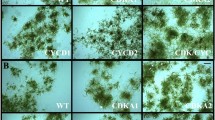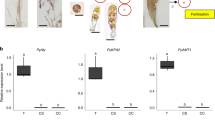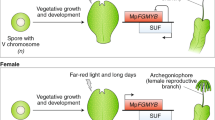Abstract
Plants characteristically alternate between haploid gametophytic and diploid sporophytic stages. Meiosis and fertilization respectively initiate these two different ontogenies1. Genes triggering ectopic embryo development on vegetative sporophytic tissues are well described2,3; however, a genetic control of embryo development from gametophytic tissues remains elusive. Here, in the moss Physcomitrella patens we show that ectopic overexpression of the homeobox gene BELL1 induces embryo formation and subsequently reproductive diploid sporophytes from specific gametophytic cells without fertilization. In line with this, BELL1 loss-of-function mutants have a wild-type phenotype, except that their egg cells are bigger and unable to form embryos. Our results identify BELL1 as a master regulator for the gametophyte-to-sporophyte transition in P. patens and provide mechanistic insights into the evolution of embryos that can generate multicellular diploid sporophytes. This developmental innovation facilitated the colonization of land by plants about 500 million years ago4 and thus shaped our current ecosystems.
This is a preview of subscription content, access via your institution
Access options
Subscribe to this journal
Receive 12 digital issues and online access to articles
$119.00 per year
only $9.92 per issue
Buy this article
- Purchase on Springer Link
- Instant access to full article PDF
Prices may be subject to local taxes which are calculated during checkout



Similar content being viewed by others
References
Friedman, W. E. One genome, two ontogenies. Science 339, 1045–1046 (2013).
Lotan, T. et al. Arabidopsis LEAFY COTYLEDON1 is sufficient to induce embryo development in vegetative cells. Cell 93, 1195–1205 (1998).
Ikeuchi, M. et al. PRC2 represses dedifferentiation of mature somatic cells in Arabidopsis. Nature Plants 1, 15089 (2015).
Bowman, J. L. Walkabout on the long branches of plant evolution. Curr. Opin. Plant Biol. 16, 70–77 (2013).
Wettstein, F. v. Morphologie und Physiologie des Formwechsels der Moose auf genetischer Grundlage I. Zeitschrift Vererbungslehre 33, 1–236 (1924).
Lang, D., Zimmer, A. D., Rensing, S. A. & Reski, R. Exploring plant biodiversity: the Physcomitrella genome and beyond. Trends Plant Sci. 13, 542–549 (2008).
Kimber, G. & Riley, R. Haploid angiosperms. Bot. Rev. 29, 480–531 (1963).
Schween, G. et al. Large-scale analysis of 73,329 Physcomitrella plants transformed with different gene disruption libraries: production parameters and mutant phenotypes. Plant Biol. 7, 228–237 (2005).
Winkler, H. Parthenogenesis und Apogamie im Pflanzenreiche. Progressus rei botanicae 2, 293–454 (1908).
Bell, P. R. Apospory and apogamy: implications for understanding the plant life cycle. Int. J. Plant Sci. 153, 123–136 (1992).
Kawashima, T. & Berger, F. Epigenetic reprogramming in plant sexual reproduction. Nature Rev. Genet. 15, 613–624 (2014).
Katz, A., Oliva, M., Mosquna, A., Hakim, O. & Ohad, N. FIE and CURLY LEAF polycomb proteins interact in the regulation of homeobox gene expression during sporophyte development. Plant J. 37, 707–719 (2004).
Mosquna, A. et al. Regulation of stem cell maintenance by the Polycomb protein FIE has been conserved during land plant evolution. Development 136, 2433–2444 (2009).
Okano, Y. et al. A polycomb repressive complex 2 gene regulates apogamy and gives evolutionary insights into early land plant evolution. Proc. Natl Acad. Sci. USA 106, 16321–16326 (2009).
Sakakibara, K. et al. KNOX2 genes regulate the haploid-to-diploid morphological transition in land plants. Science 339, 1067–1070 (2013).
Lee, J.-H., Lin, H., Joo, S. & Goodenough, U. Early sexual origins of homeoprotein heterodimerization and evolution of the plant KNOX/BELL family. Cell 133, 829–840 (2008).
Bellaoui, M. et al. The Arabidopsis BELL1 and KNOX TALE homeodomain proteins interact through a domain conserved between plants and animals. Plant Cell 13, 2455–2470 (2001).
Dolan, L. Plant evolution: TALES of development. Cell 133, 771–773 (2008).
Reiser, L. et al. The BELL1 gene encodes a homeodomain protein involved in pattern formation in the Arabidopsis ovule primordium. Cell 83, 735–742 (1995).
Rutjens, B. et al. Shoot apical meristem function in Arabidopsis requires the combined activities of three BEL1-like homeodomain proteins. Plant J. 58, 641–654 (2009).
Bencivenga, S., Simonini, S., Benková, E. & Colombo, L. The transcription factors BEL1 and SPL are required for cytokinin and auxin signaling during ovule development in Arabidopsis. Plant Cell 24, 2886–2897 (2012).
Zimmer, A. D. et al. Reannotation and extended community resources for the genome of the non-seed plant Physcomitrella patens provide insights into the evolution of plant gene structures and functions. BMC Genomics 14, 498 (2013).
Frank, M. H. & Scanlon, M. J. Transcriptomic evidence for the evolution of shoot meristem function in sporophyte-dominant land plants through concerted selection of ancestral gametophytic and sporophytic genetic programs. Mol. Biol. Evol. 32, 355–367 (2015).
Widiez, T. et al. The chromatin landscape of the moss Physcomitrella patens and its dynamics during development and drought stress. Plant J. 79, 67–81 (2014).
Holferty, G. M. The archegonium of Mnium cuspidatum. Bot. Gaz. 37, 106–126 (1904).
Harrison, C. J., Roeder, A. H. K., Meyerowitz, E. M. & Langdale, J. A. Local cues and asymmetric cell divisions underpin body plan transitions in the moss Physcomitrella patens. Curr. Biol. 19, 461–471 (2009).
Schween, G., Gorr, G., Hohe, A. & Reski, R. Unique tissue-specific cell cycle in Physcomitrella. Plant Biol. 5, 50–58 (2003).
Kingham, K. I., Duckett, J. G., Glyn, M. C. P. & Leitch, A. R. Nuclear differentiation in the filamentous caulonema of the moss Funaria hygrometrica. New Phytol. 131, 543–556 (1995).
Budke, J. M., Goffinet, B. & Jones, C. S. Dehydration protection provided by a maternal cuticle improves offspring fitness in the moss Funaria hygrometrica. Ann. Bot. 111, 781–789 (2013).
Mukherjee, K., Brocchieri, L. & Burglin, T. R. A comprehensive classification and evolutionary analysis of plant Homeobox genes. Mol. Biol. Evol. 26, 2775–2794 (2009).
Furumizu, C., Alvarez, J. P., Sakakibara, K. & Bowman, J. L. Antagonistic roles for KNOX1 and KNOX2 genes in patterning the land plant body plan following an ancient gene duplication. PLoS Genet. 11, e1004980 (2015).
Ranganath, R. M. Developmental switches that hold the key to a revolution in crop biotechnology. Nature Rev. Genet. 12, 224 (2011).
Spillane, C., Curtis, M. D. & Grossniklaus, U. Apomixis technology development—virgin births in farmers’ fields? Nature Biotechnol. 22, 687–691 (2004).
Rensing, S. A. et al. The Physcomitrella genome reveals evolutionary insights into the conquest of land by plants. Science 319, 64–69 (2008).
Reski, R. & Abel, W. O. Induction of budding on chloronemata and caulonemata of the moss, Physcomitrella patens, using isopentenyladenine. Planta 165, 354–358 (1985).
Egener, T. et al. High frequency of phenotypic deviations in Physcomitrella patens plants transformed with a gene-disruption library. BMC Plant Biol. 2, 6 (2002).
Frank, W., Decker, E. L. & Reski, R. Molecular tools to study Physcomitrella patens. Plant Biol. 7, 220–227 (2005).
Hohe, A., Rensing, S. A., Mildner, M., Lang, D. & Reski, R. Day length and temperature strongly influence sexual reproduction and expression of a novel MADS-box gene in the moss Physcomitrella patens. Plant Biol. 4, 595–602 (2002).
Kamisugi, Y., Cuming, A. C. & Cove, D. J. Parameters determining the efficiency of gene targeting in the moss Physcomitrella patens. Nucleic Acids Res. 33, e173 (2005).
Büttner-Mainik, A. et al. Production of biologically active recombinant human factor H in Physcomitrella: production of recombinant human factor H. Plant Biotechnol. J. 9, 373–383 (2011).
Hohe, A. et al. An improved and highly standardised transformation procedure allows efficient production of single and multiple targeted gene-knockouts in a moss, Physcomitrella patens. Curr. Genet. 44, 339–347 (2004).
Bierfreund, N. M., Tintelnot, S., Reski, R. & Decker, E. L. Loss of GH3 function does not affect phytochrome-mediated development in a moss, Physcomitrella patens. J. Plant Physiol. 161, 823–835 (2004).
Acknowledgements
We thank J. Berman, P. Beyer, M. Lawton and G. Igloi for helpful comments on drafts of the manuscript, N. van Gessel for bioinformatic support, A. K. Prowse for proofreading and A. Novakovic for technical assistance. This work was supported by funds from the German-Israeli Foundation for Scientific Research and Development (GIF I-832-130.12/2004 and I-1008-154.13-2008 to N.O. and R.R.) and by the Excellence Initiative of the German Federal and State Governments (EXC294 to R.R.). I.P. was supported in part by a matching Tel-Aviv University Deans doctoral fellowship and the Manna foundation.
Author information
Authors and Affiliations
Contributions
N.A.H. generated and analysed the PpBELL1oe lines and analysed the FIE/BELL1 double knockouts and MKN expression. A.K. generated and I.P. analysed the BELL1 knockouts; N.A.H. analysed sperms and egg cells of the BELL1 knockouts. A.K. generated and I.P., N.A.H. and N.O. analysed the BELL–GUS lines. A.K., N.A.H. and I.P. analysed BELL gene expression. A.K. and N.O. performed the BiFC experiments. N.A.H. performed additional analyses documented in Supplementary Figs 1, 2, 8 and 12. A.K., E.L.D., N.O. and R.R. planned and supervised the study. R.R., N.A.H. and N.O. wrote the manuscript. All authors discussed the results and commented on the manuscript.
Corresponding authors
Ethics declarations
Competing interests
The authors declare no competing financial interests.
Rights and permissions
About this article
Cite this article
Horst, N., Katz, A., Pereman, I. et al. A single homeobox gene triggers phase transition, embryogenesis and asexual reproduction. Nature Plants 2, 15209 (2016). https://doi.org/10.1038/nplants.2015.209
Received:
Accepted:
Published:
DOI: https://doi.org/10.1038/nplants.2015.209
This article is cited by
-
Protocol: an improved method for inducing sporophyte generation in the model moss Physcomitrium patens under nitrogen starvation
Plant Methods (2023)
-
Mutation in Polycomb repressive complex 2 gene OsFIE2 promotes asexual embryo formation in rice
Nature Plants (2023)
-
Bryophytes as Modern Model Plants: An Overview of Their Development, Contributions, and Future Prospects
Journal of Plant Growth Regulation (2023)
-
A synthetic protein as efficient multitarget regulator against complement over-activation
Communications Biology (2022)
-
The origin of a land flora
Nature Plants (2022)



